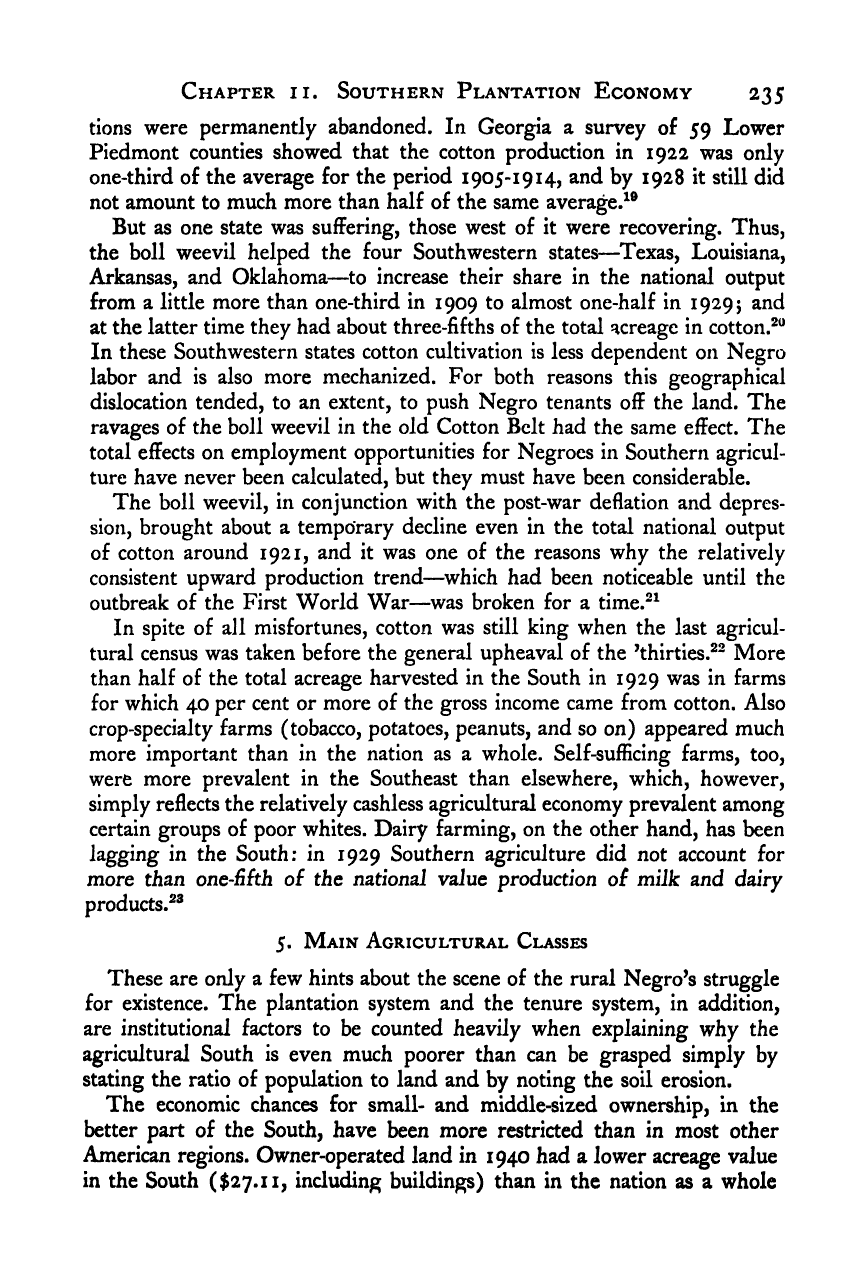Note: Gunnar Myrdal died in 1987, less than 70 years ago. Therefore, this work is protected by copyright, restricting your legal rights to reproduce it. However, you are welcome to view it on screen, as you do now. Read more about copyright.
Full resolution (TIFF) - On this page / på denna sida - IV. Economics - 11. The Southern Plantation Economy and the Negro Farmer - 4. The Boll Weevil - 5. Main Agricultural Classes

<< prev. page << föreg. sida << >> nästa sida >> next page >>
Below is the raw OCR text
from the above scanned image.
Do you see an error? Proofread the page now!
Här nedan syns maskintolkade texten från faksimilbilden ovan.
Ser du något fel? Korrekturläs sidan nu!
This page has never been proofread. / Denna sida har aldrig korrekturlästs.
Chapter ii. Southern Plantation Economy 235
tions were permanently abandoned. In Georgia a survey of 59 Lower
Piedmont counties showed that the cotton production in 1922 was only
one-third of the average for the period 1905-19 14, and by 1928 it still did
not amount to much more than half of the same average.^®
But as one state was suffering, those west of it were recovering. Thus,
the boll weevil helped the four Southwestern states—^Texas, Louisiana,
Arkansas, and Oklahoma—to increase their share in the national output
from a little more than one-third in 1909 to almost one-half in 19295 and
at the latter time they had about three-fifths of the total acreage in cotton.^^
In these Southwestern states cotton cultivation is less dependent on Negro
labor and is also more mechanized. For both reasons this geographical
dislocation tended, to an extent, to push Negro tenants off the land. The
ravages of the boll weevil in the old Cotton Belt had the same effect. The
total effects on employment opportunities for Negroes in Southern agricul-
ture have never been calculated, but they must have been considerable.
The boll weevil, in conjunction with the post-war deflation and depres-
sion, brought about a temporary decline even in the total national output
of cotton around 1921, and it was one of the reasons why the relatively
consistent upward production trend—^which had been noticeable until the
outbreak of the First World War—was broken for a time.^^
In spite of all misfortunes, cotton was still king when the last agricul-
tural census was taken before the general upheaval of the ^thirties.^- More
than half of the total acreage harvested in the South in 1929 was in farms
for which 40 per cent or more of the gross income came from cotton. Also
crop-specialty farms (tobacco, potatoes, peanuts, and so on) appeared much
more important than in the nation as a whole. Self-sufficing farms, too,
were more prevalent in the Southeast than elsewhere, which, however,
simply reflects the relatively cashless agricultural economy prevalent among
certain groups of poor whites. Dairy farming, on the other hand, has been
lagging in the South; in 1929 Southern agriculture did not account for
more than one^Efth of the national value production of milk and dairy
products.^^
5. Main Agricultural Classes
These are only a few hints about the scene of the rural Negroes struggle
for existence. The plantation system and the tenure system, in addition,
are institutional factors to be counted heavily when explaining why the
agricultural South is even much poorer than can be grasped simply by
stating the ratio of population to land and by noting the soil erosion.
The economic chances for small- and middle-sized ownership, in the
better part of the South, have been more restricted than in most other
American regions. Owner-operated land in 1940 had a lower acreage value
in the South ($27.11, including buildings) than in the nation as a whole
<< prev. page << föreg. sida << >> nästa sida >> next page >>